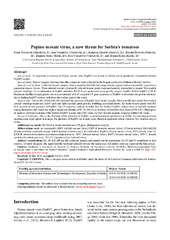Приказ основних података о документу
Short communication: Pepino mosaic virus, a new threat for Serbia’s tomatoes
| dc.creator | Stanković, Ivana | |
| dc.creator | Vučurović, Ana | |
| dc.creator | Zečević, Katarina | |
| dc.creator | Petrović, Branka | |
| dc.creator | Ristić, Lela | |
| dc.creator | Vučurović, Ivan | |
| dc.creator | Krstić, Branka | |
| dc.date.accessioned | 2023-07-11T11:29:24Z | |
| dc.date.available | 2023-07-11T11:29:24Z | |
| dc.date.issued | 2020 | |
| dc.identifier.issn | 2171-9292 | |
| dc.identifier.uri | https://plantarum.izbis.bg.ac.rs/handle/123456789/643 | |
| dc.description.abstract | Aim of study: To report the occurrence of Pepino mosaic virus (PepMV) on tomato in Serbia and to genetically characterize Serbian PepMV isolates. Area of study: Tomato samples showing virus-like symptoms were collected in the Bogojevce locality (Jablanica District, Serbia). Material and methods: Collected tomato samples were assayed by DAS-ELISA using antisera against eight economically important or quarantine tomato viruses. Three selected isolates of naturally infected tomato plants were mechanically transmitted to tomato ‘Novosadski jabučar’ seedlings. For confirmation of PepMV infection, RT-PCR was performed using specific primers PepMV TGB F/PepMV UTR R. Maximum-likelihood phylogenetic tree was constructed with 47 complete CP gene sequences of PepMV to determine the genetic relationship of Serbian PepMV isolates with those from other parts of the world. Main results: The results of DAS-ELISA indicated the presence of PepMV in all tested samples. Mechanically inoculated ‘Novosadski jabučar’ seedlings expressed yellow spots and light and dark green patches, bubbling, and curled leaves. All tested tomato plants were RTPCR positive for the presence of PepMV. The CP sequence analysis revealed that the Serbian PepMV isolates were completely identical among themselves and shared the highest nucleotide identity of 95.1% (99.2% aa identity) with isolate from Spain (FJ263341). Phylogenetic analysis showed clustering of the Serbian PepMV isolates into CH2 strain, but they formed separate subgroup within CH2 strain. Research highlights: This is the first data of the presence of PepMV in protected tomato production in Serbia. Considering increased incidence and rapid spread in Europe, the presence of PepMV on tomato could therefore represent serious threat to this valuable crop in Serbia | sr |
| dc.language.iso | en | sr |
| dc.publisher | Instituto Nacional de Investigación y Tecnología Agraria y Alimentaria (INIA) | sr |
| dc.relation | info:eu-repo/grantAgreement/MESTD/inst-2020/200116/RS// | sr |
| dc.relation | info:eu-repo/grantAgreement/MESTD/inst-2020/200010/RS// | sr |
| dc.rights | openAccess | sr |
| dc.rights.uri | https://creativecommons.org/licenses/by/4.0/ | |
| dc.source | Spanish Journal of Agricultural Research | sr |
| dc.subject | ELISA test | sr |
| dc.subject | molecular detection | sr |
| dc.subject | CP gene | sr |
| dc.subject | phylogenetic analysis | sr |
| dc.title | Short communication: Pepino mosaic virus, a new threat for Serbia’s tomatoes | sr |
| dc.type | article | sr |
| dc.rights.license | BY | sr |
| dc.citation.issue | 4 | |
| dc.citation.volume | 18 | |
| dc.type.version | publishedVersion | sr |
| dc.identifier.doi | 10.5424/sjar/2020184-16244 | |
| dc.identifier.fulltext | http://plantarum.izbis.bg.ac.rs/bitstream/id/2781/bitstream_2781.pdf | |
| dc.identifier.scopus | 2-s2.0-85101435177 | |
| dc.identifier.wos | 000617035900008 |


